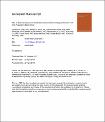Why is maternal depression related to adolescent internalizing problems? : a 15-year population-based study
| dc.contributor.author | Côté, Sylvana | |
| dc.contributor.author | Ahun, Marilyn N. | |
| dc.contributor.author | Herba, Catherine | |
| dc.contributor.author | Brendgen, Mara | |
| dc.contributor.author | Geoffroy, Marie-Claude | |
| dc.contributor.author | Orri, Massimiliano | |
| dc.contributor.author | Liu, Xuecheng | |
| dc.contributor.author | Vitaro, Frank | |
| dc.contributor.author | Melchior, Maria | |
| dc.contributor.author | Boivin, Michel | |
| dc.contributor.author | Tremblay, Richard Ernest | |
| dc.date.accessioned | 2020-05-05T15:56:34Z | |
| dc.date.available | NO_RESTRICTION | fr |
| dc.date.available | 2020-05-05T15:56:34Z | |
| dc.date.issued | 2018-09-20 | |
| dc.identifier.uri | http://hdl.handle.net/1866/23330 | |
| dc.publisher | Elsevier | fr |
| dc.subject | Maternal depression | fr |
| dc.subject | Adolescent internalizing problems | fr |
| dc.subject | Peer victimization | fr |
| dc.subject | Parenting | fr |
| dc.subject | Friendship quality | fr |
| dc.title | Why is maternal depression related to adolescent internalizing problems? : a 15-year population-based study | fr |
| dc.type | Article | fr |
| dc.contributor.affiliation | Université de Montréal. École de santé publique. Département de médecine sociale et préventive | fr |
| dc.identifier.doi | 10.1016/j.jaac.2018.04.024 | |
| dcterms.abstract | Objective: Exposure to maternal depression during early childhood is a well-documented risk factor for offspring's internalizing problems, but the long-term risk and the psychosocial mechanisms underlying the association remain largely unknown. We examined whether maternal depression during early childhood was associated with offspring internalizing problems in adolescence, and the extent to which negative parenting, peer victimization, and poor friendship quality during middle childhood mediated this association. Method: We report on a population-based sample of children (n=1443) followed-up from 5 months to 15 years. We use yearly assessments of the exposure variable – maternal depression (5 months-5 years); the putative mediators – peer victimization, friendship quality, and parenting practices (6-12 years); and assessment of the outcome variables at 15 years: self-reported major depressive (MD), generalized anxiety (GA), and social phobia (SP) symptoms. Structural Equation Modeling was used to test mediation by peer and family relationships. Results: Exposure to maternal depression during early childhood was associated with higher levels of adolescent MD, GA and SP. Peer victimization was the only significant mediator and explained 35.9% of the association with adolescent MD; 22.1% with GA; and 22.1% with SP. Conclusion: Exposure to maternal depression prior to age 5 years was associated with depression, anxiety, and social phobia extending to adolescence via its impact on peer victimization during middle childhood. Particular attention should be paid to victimization as one potential psychosocial factor via which maternal depression is associated with adolescent internalizing problems. | fr |
| dcterms.isPartOf | urn:ISSN:0890-8567 | fr |
| dcterms.isPartOf | urn:ISSN:1527-5418 | fr |
| dcterms.language | eng | fr |
| UdeM.ReferenceFournieParDeposant | Côté, S. M., Ahun, M. N., Herba, C. M., Brendgen, M., Geoffroy, M. C., Orri, M., ... & Tremblay, R. E. (2018). Why is maternal depression related to adolescent internalizing problems? A 15-year population-based study. Journal of the American Academy of Child & Adolescent Psychiatry, 57(12), 916-924. | fr |
| UdeM.VersionRioxx | Version acceptée / Accepted Manuscript | fr |
| oaire.citationTitle | Journal of the American academy of child and adolescent psychiatry | |
| oaire.citationVolume | 57 | |
| oaire.citationIssue | 12 | |
| oaire.citationStartPage | 916 | |
| oaire.citationEndPage | 924 |
Files in this item
This item appears in the following Collection(s)
This document disseminated on Papyrus is the exclusive property of the copyright holders and is protected by the Copyright Act (R.S.C. 1985, c. C-42). It may be used for fair dealing and non-commercial purposes, for private study or research, criticism and review as provided by law. For any other use, written authorization from the copyright holders is required.


